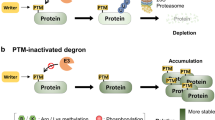Abstract
The ability to adequately measure the phosphorylation state of a protein has major biological as well as clinical relevance. Due to its variable nature, reversible protein phosphorylations are sensitive to changes in the tissue environment. Stabilizor T1 is a system for rapid inactivation of enzymatic activity in biological samples. Enzyme inactivation is accomplished using thermal denaturation in a rapid, homogeneous, and reproducible fashion without the need for added inhibitors. Using pCREB(Ser133) as a model system, the applicability of the Stabilizor system to preserve a rapidly lost phosphorylation is shown.
Access this chapter
Tax calculation will be finalised at checkout
Purchases are for personal use only
Similar content being viewed by others
References
Cohen, P. (2000) The regulation of protein function by multisite phosphorylation – a 25 year update. Trends Biochem. Sci. 25, 596–601.
Voshol, H., Ehrat, M., Traenkle, J., Bertrand, E. and van Oostrum, J. (2009) Antibody-based proteomics-analysis of signaling networks using reverse protein arrays. FEBS J. 276, 6871–6879.
Hunter, T. (1987) A thousand and one protein kinases. Cell 50, 823–829.
Li Jianlin, G.T.D., Yuan Peixiong, Manji Husseini, K. and Chen Guang (2003) Post-mortem interval effects on the phosphorylation of signaling proteins. Neuropsychopharmacology 28, 1017–1025.
True, L.D. (2008) Quality control in molecular immunohistochemistry. Histochem. Cell Biol. 130, 473–480.
Espina, V., Edmiston, K.H., Heiby, M., Pierobon, M., Sciro, M., Merritt, B., et al. (2008) A portrait of tissue phosphoprotein stability in the clinical tissue procurement process. Mol. Cell. Proteomics 7, 1998–2018.
Espina, V., Mueller, C., Edmiston, K., Sciro, M., Petricoin, E.F. and Liotta, L.A. (2009) Tissue is alive: new technologies are needed to address the problems of protein biomarker pre-analytical variability. Proteomics Clin. Appl. 3, 874–882.
Fox, C.H., Johnson, F.B., Whiting, J. and Roller, P.P. (1985) Formaldehyde fixation. J. Histochem. Cytochem. 33, 845–853.
Mandell, J.W. (2003) Phosphorylation state-specific antibodies: applications in investigative and diagnostic pathology. Am. J. Pathol. 163, 1687–1698.
Mandell, J.W. (2008) Immunohistochemical assessment of protein phosphorylation state: the dream and the reality. Histochem. Cell Biol. 130, 465–471.
Svensson, M., Borén, M., Sköld, K., Fälth, M., Sjögren, B., Andersson, M., et al. (2009) Heat stabilization of the tissue proteome: a new technology for improved proteomics. J. Proteome Res. 8, 974–981.
Li, X., Friedman, B.A., Roh M.-S., and Richard, J.S. (2005) Anesthesia and post-mortem interval profoundly influence the regulatory serine phosphorylation of glycogen synthase kinase-3 in mouse brain. J. Neurochem. 92, 701–704.
Acknowledgments
The author is thankful to Inga Hansson for skilfully carrying out IHC procedures and Charlotte Emlind-Vahlu for much appreciated advice on the manuscript.
Author information
Authors and Affiliations
Corresponding author
Editor information
Editors and Affiliations
Rights and permissions
Copyright information
© 2011 Springer Science+Business Media, LLC
About this protocol
Cite this protocol
Borén, M. (2011). Methodology and Technology for Stabilization of Specific States of Signal Transduction Proteins. In: Kalyuzhny, A. (eds) Signal Transduction Immunohistochemistry. Methods in Molecular Biology, vol 717. Humana Press. https://doi.org/10.1007/978-1-61779-024-9_5
Download citation
DOI: https://doi.org/10.1007/978-1-61779-024-9_5
Published:
Publisher Name: Humana Press
Print ISBN: 978-1-61779-023-2
Online ISBN: 978-1-61779-024-9
eBook Packages: Springer Protocols




